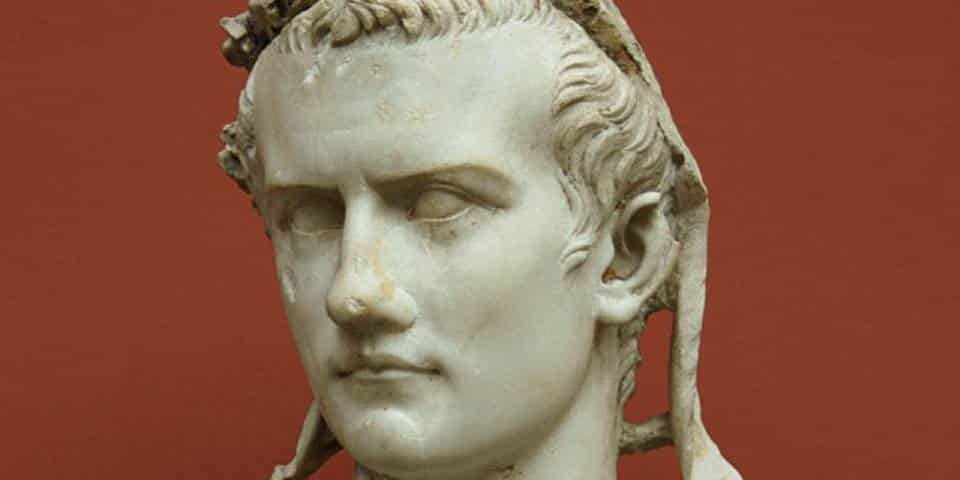

24856 views

Caligula (Gaius Julius Augustus Germanicus) was a Roman emperor from 37 AD to 41 AD. He was the son of Roman general Germanicus and Augustus‘ granddaughter Agrippina the Elder. Thus, Caligula was the representative of the first ruling family of the ancient Roman Empire, known as the Julio-Claudian dynasty.
Although he was born Gaius Caesar, after Julius Caesar, he got the nickname “Caligula,” which means “little soldier’s boot,” from his father’s soldiers during their campaign in Germany. His father died in 19 AD, and his mother returned to Rome with six children.
Agrippina conflicted with Tiberius, which led to the destruction of her family, where only Caligula survived among all her children. So Caligula moved to Tiberius to the Capri island, where following the emperor’s death, Caligula succeeded his adoptive grandfather and started his reign in 37 AD.
Caligula was famous for his cruelty, extravagance, sadism, and sexual perversion.
His first six months of reign were auspicious for citizens, but then he became an insane tyrant. He worked on construction projects of two aqueducts in Rome: the Aqua Claudia and the Anio Novus. Moreover, he commissioned the construction of several luxurious dwellings for himself. Finally, in 41 AD, Caligula was assassinated because of a conspiracy by officers of the Praetorian Guard and courtiers. On the same day of his death, Caligula’s uncle, Claudius, was proclaimed the next Roman emperor. However, even though the Julio-Claudian dynasty continued to reign over the empire until the fall of his nephew Nero in 68 AD, Caligula’s death was considered the official end of the Julii Caesares among male representatives.
Read about Roman Emperors who were Assassinated.
Contents
ToggleGaius Julius Caesar was born in the modern territory of Anzio and Nettuno in 12 AD. He was the third of six surviving children born to Germanicus. Being a boy of two-three years old, he accompanied his father on campaigns in the north of Germany. He received his nickname “Caligula” from other soldiers, who were amazed that Gaius was dressed in a small soldier’s outfit, including a weapon and boots. However, the future emperor did not really like his nickname.
After the death of Germanicus, Caligula lived with Agrippina until she became an enemy of Tiberius. The emperor did not allow her to remarry, being feared that her husband could become his rival. Consequently, in 29 AD, Caligula’s mother and brother Nero were banished. Caligula moved to Capri island to live with his great-grandmother and mother of Tiberius, Livia. Later, after her death, he moved to his grandmother Antonia Minor.
In 33 AD, Caligula held an honorary quaestorship from Caligula before becoming an emperor
Tiberius died in 37 AD, and all his estate and titles were transferred to Caligula. During the beginning of his reign, over 160.000 animals were sacrificed during the first three months to celebrate the coming of the new blissful emperor. People loved him because he granted bonuses to the military, including the Praetorian Guard, city troops, and the army out of Italy. Before, Tiberius created treason trials that Caligula canceled. Moreover, he maintained those who had been hurt by the imperial system and ejected sexual deviants.
However, after six months of power, everything changed. Historians assume a possible breakdown or epilepsy of Caligula, but he became a different person as a result. If the taxes were reduced at the beginning of his reign, he raised them to pay for his excesses after six months. He became more paranoid and instituted purges against his enemies, including his first wife. Moreover, the treason trials of Tiberius were returned. Caligula also condemned people to confiscate their property. His life became insane. Caligula’s response to his acts was: “Let them hate me, so long as they fear me.” His way of the reign was also crazy because he spent taxes on weddings, prostitution, lawsuits and started to sell the lives of the gladiators at shows.
Caligula worked on many construction projects during his four years of reign. He improved the temple of Augustus and the theatre of Pompey. In addition, the emperor began an amphitheater beside the Saepta and made the imperial palace bigger. Importantly, a large racetrack known as the “Circus of Gaius and Nero” was built by him.
An Egyptian obelisk that stands nowadays in Saint Peter’s Square was transported under his commission in 37 AD. At Syracuse, Caligula repaired the city walls and many temples dedicated to various gods. Also, many new roads were constructed and maintained in good condition.
Caligula had two largge ships built for himself that were recovered from the bottom of Lake Nemi at the beginning of 20th century
These ships were among the biggest constructions of this kind in the ancient world. The smaller ship was designed as a temple dedicated to the goddess Diana, while the larger one was a floating palace with a beautiful interior and marble floors. Unfortunately, in 1944, during an attack in the Second World War, ships were burned. Still, many ancient treasures are in the museum at Lake Nemi and the Museo Nazionale Romano in Rome.
Caligula and the Senate had difficult relationships. Especially in 39 AD, the situation became worse than ever for an unknown reason. Undoubtedly, one of the causes was that the Senate became accustomed to rule without an emperor since Tiberius spent many years on Capri Island. Caligula replaced the consul and had several senators put to death. It happened when the emperor reviewed Tiberius’s papers of treason trials and decided that many representatives of the senate were not trustworthy.
In 40 AD, Caligula expanded the Empire into Mauretania, ruled by Ptolemy of Mauretania. He invited Ptolemy to Rome and suddenly had him murdered. Consequently, Caligula divided Mauretania into two provinces: Mauretania Tingitana and Mauretania Caesariensis, separated by the river Malua. The emperor even led meaningless campaigns in Germany to earn some sense of military glory. During one of these campaigns, Caligula ordered his soldiers to collect seashells. He brought them back to Rome and exhibited. Modern historians assume that the mission may have been to accept the surrender of the British chieftain Adminius.
Moreover, seashells in Latin translate as “conchae,” and it could be a metaphor for something else as female genitalia (for instance, the troops visited brothels) or could capture several small British boats.
Caligula was emperor for four years, and in 41 AD, he was assassinated by members of the Praetorian Guard. Moreover, his wife, Caesonia, and daughter were murdered, so his successor became Claudius, whom he ridiculed for many years.
Read also about Emperor Caracalla
Caligula (Caligola) is a 1979 Italian-American erotic historical drama movie about the life of emperor Caligula. Watch this amazing film with Malcolm McDowell, Teresa Ann Savoy, Helen Mirren, Peter O’Toole, John Steiner, and John Gielgud. The film’s producer is Bob Guccione, the founder of Penthouse magazine.
Here are 15 interesting facts about Caligula to remember a few to surprise friends during historical debates:
Author: Kate Zusmann
This website uses cookies. For more info read the cookies policy
Rome.us © 2025. Created with love by Roman experts and guides.